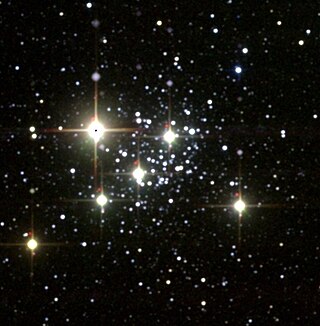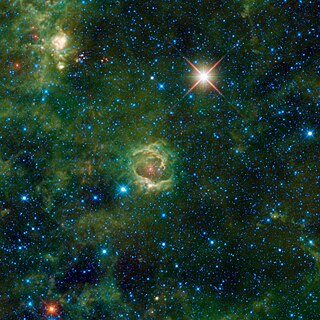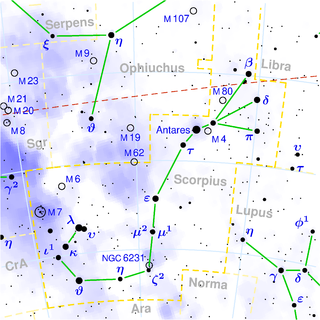
Scutum is a small constellation. Its name is Latin for shield, and it was originally named Scutum Sobiescianum by Johannes Hevelius in 1684. Located just south of the celestial equator, its four brightest stars form a narrow diamond shape. It is one of the 88 IAU designated constellations defined in 1922.

Red supergiants (RSGs) are stars with a supergiant luminosity class of spectral type K or M. They are the largest stars in the universe in terms of volume, although they are not the most massive or luminous. Betelgeuse and Antares are the brightest and best known red supergiants (RSGs), indeed the only first magnitude red supergiant stars.

The Scutum–Centaurus Arm, also known as Scutum-Crux arm, is a long, diffuse curving streamer of stars, gas and dust that spirals outward from the proximate end of the Milky Way's central bar. The Milky Way has been posited since the 1950s to have four spiral arms — numerous studies contest or nuance this number. In 2008, observations using the Spitzer Space Telescope failed to show the expected density of red clump giants in the direction of the Sagittarius and Norma arms. In January 2014, a 12-year study into the distribution and lifespan of massive stars and a 2013-reporting study of the distribution of masers and open clusters both found corroboratory, though would not state irrefutable, evidence for four principal spiral arms.

NGC 663 is a young open cluster in the constellation of Cassiopeia. It has an estimated 400 stars and spans about a quarter of a degree across the sky. It can reportedly be detected with the unaided eye, although a telescope is recommended for best viewing. The brightest members of the cluster can be viewed with binoculars. Although the listed visual magnitude is 7.1, several observers have reported higher estimates.

Westerlund 1 is a compact young super star cluster about 3.8 kpc away from Earth. It is thought to be the most massive young star cluster in the Milky Way, and was discovered by Bengt Westerlund in 1961 but remained largely unstudied for many years due to high interstellar absorption in its direction. In the future, it will probably evolve into a globular cluster.

MY Cephei is a red supergiant located in open cluster NGC 7419 in the constellation of Cepheus. It is a semiregular variable star with a maximum brightness of magnitude 14.4 and a minimum of magnitude 15.5.

A hypergiant (luminosity class 0 or Ia+) is a very rare type of star that has an extremely high luminosity, mass, size and mass loss because of its extreme stellar winds. The term hypergiant is defined as luminosity class 0 (zero) in the MKK system. However, this is rarely seen in literature or in published spectral classifications, except for specific well-defined groups such as the yellow hypergiants, RSG (red supergiants), or blue B(e) supergiants with emission spectra. More commonly, hypergiants are classed as Ia-0 or Ia+, but red supergiants are rarely assigned these spectral classifications. Astronomers are interested in these stars because they relate to understanding stellar evolution, especially star formation, stability, and their expected demise as supernovae.
Alicante 8, also known as RSGC4, is a young massive open cluster belonging to the Milky Way galaxy. It was discovered in 2010 in the 2MASS survey data. As of 2010, the only members of the cluster that are currently identified are 8–13 red supergiants—young massive stars undergoing helium burning in their cores. The cluster is located in the constellation Scutum at the distance of about 20–23 kly (6–7 kpc) from the Sun. It is likely situated at the intersection of the northern end of the Long Bar of the Milky Way and the inner portion of the Scutum–Centaurus Arm—one of the two major spiral arms.
RSGC3 is a young massive open cluster belonging to the Milky Way galaxy. It was discovered in 2010 in the GLIMPSE survey data. The cluster is located in the constellation Scutum at the distance of about 7 kpc from the Sun. It is likely situated at the intersection of the northern end of the Long Bar of the Milky Way and the inner portion of the Scutum–Centaurus Arm—one of its two major spiral arms.

Stephenson 2, also known as RSGC2, is a young massive open cluster belonging to the Milky Way galaxy. It was discovered in 1990 as a cluster of red supergiants in a photographic, deep infrared survey by the astronomer Charles Bruce Stephenson, after whom the cluster is named. It is located in the constellation Scutum at the distance of about 6 kpc from the Sun. It is likely situated at the intersection of the northern end of the Long Bar of the Milky Way and the inner portion of the Scutum–Centaurus Arm—one of the two major spiral arms.

RSGC1 is a young massive open cluster in the Milky Way galaxy. It was discovered in 2006 in the data generated by several infrared surveys, named for the unprecedented number of red supergiant members. The cluster is located in the constellation Scutum at the distance of about 6.6 kpc from the Sun. It is likely situated at the intersection of the northern end of the Long Bar of the Milky Way and the inner portion of the Scutum–Centaurus Arm—one of its two major spiral arms.

PZ Cassiopeiae is a red supergiant star located in the Cassiopeia constellation, and a semi-regular variable star.

HD 160529 is a luminous blue variable (LBV) star located in the constellation of Scorpius. With an apparent magnitude of around +6.8 cannot be seen with the naked eye except under very favourable conditions, but it is easy to see with binoculars or amateur telescopes.

UY Scuti (BD-12°5055) is an extreme red hypergiant or red supergiant star in the constellation Scutum. It is considered one of the largest known stars by radius and is also a pulsating variable star, with a maximum brightness of magnitude 8.29 and a minimum of magnitude 10.56. It has an estimated radius of 1,708 solar radii (1.188×109 kilometres; 7.94 astronomical units), thus a volume nearly 5 billion times that of the Sun. It is approximately 2.9 kiloparsecs (9,500 light-years) from Earth. If placed at the center of the Solar System, its photosphere would at least engulf the orbit of Jupiter.

AH Scorpii is a red supergiant variable star located in the constellation Scorpius. It is one of the largest stars known by radius and is also one of the most luminous red supergiant stars in the Milky Way.
IRC −10414 is a red supergiant and runaway star in the constellation Scutum, a rare case of a red supergiant with a bow shock.

Westerlund 1-237 or Wd 1-237 is a possible red supergiant (RSG) in the constellation of Ara. It is one out of 4 known red supergiants in the Westerlund 1 super star cluster, although its outlying position, spectrum, and parallax, suggest it could be a foreground giant. As a red supergiant, it would be one of the largest known stars and one of most luminous of its type.
Alicante 10, also known as RSGC6, is a young massive open cluster belonging to the Milky Way galaxy. It was discovered in 2012 in the 2MASS survey data. Currently, eight red supergiants have been identified in this cluster. Alicante 10 is located in the constellation Scutum at the distance of about 6000 pc from the Sun. It is likely situated at the intersection of the northern end of the Long Bar of the Milky Way and the inner portion of the Scutum–Centaurus Arm—one of the two major spiral arms.

IRAS 18357–0604 is a yellow hypergiant (YHG) star located in the constellation of Scutum, estimated to be about 19,600 light years, or 6,000 parsecs, away. IRAS 18357–0604 is remarkably similar to IRC +10420, another yellow hypergiant in the constellation of Aquila.
Stephenson 2 DFK 49 or St2-11 is a putative post red supergiant star in the constellation Scutum. It is located in the massive open cluster Stephenson 2. It is possibly one of the largest known stars with radius estimates ranging from almost 1,000 solar radii to 1,300 solar radii. If the upper estimate is correct, then Stephenson 2 DFK 49 has a volume 2.2 billion times that of the Sun. If it was placed at the center of the Solar System, its photosphere will potentially approach or engulf Jupiter's orbit. It loses mass at a very high rate, resulting in large amounts of Infrared excess.


















